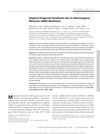Development of a Mouse Model for Hutchinson-Gilford Progeria Syndrome Reveals Defects in Adult Stem Cell Maintenance
March 2011
in “
Open Archive (Karolinska Institutet)
”
TLDR The mouse model showed defects in adult stem cell maintenance related to Hutchinson-Gilford progeria syndrome.
The study developed an inducible mouse model to investigate the cellular effects of the common Hutchinson-Gilford progeria syndrome (HGPS) mutation, which is caused by a point mutation in the LMNA gene. This model expressed a human mini gene for lamin A with the c.1824C>T mutation, leading to over-expression of both wild-type lamin A and the mutated form, progerin. The targeted expression in keratin 5-expressing tissues resulted in a progressive skin phenotype similar to that seen in HGPS patients, evolving from hyperplasia to hypoplasia and loss of subcutaneous fat. The study found no effects of progerin expression on the hair cycle or lamin B expression. The model also showed that embryonic expression of progerin led to a rapidly progressing phenotype. This mouse model provided insights into the molecular mechanisms of HGPS skin symptoms and could be useful for testing treatments and studying tissue-specific effects in HGPS.







